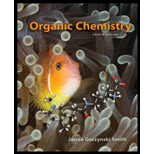
Concept explainers
Reaction of pentanoyl chloride
Trending nowThis is a popular solution!

Chapter 13 Solutions
Package: Organic Chemistry With Connect 2-semester Access Card
Additional Science Textbook Solutions
Basic Chemistry
General, Organic, and Biological Chemistry - 4th edition
Chemistry: Structure and Properties
Chemistry & Chemical Reactivity
Chemistry (7th Edition)
Elementary Principles of Chemical Processes, Binder Ready Version
- compound with the molecular formula C7H9N exhibits IR bands at 3450 cm-1 (medium, doublet), and 855 cm-1 (strong) and shows the following major mass spectral signals (m/z): 106 (base); 107 (M+, about 70% of base), 91 (40% of base), and 77 (about 20% of base). Deduce a reasonable structure from this data.arrow_forwardReaction of tert-butyl pentyl ether [CH3CH2CH2CH2CH2OC(CH3)3] with HBr forms 1-bromopentane (CH3CH2CH2CH2CH2Br) and compound B. B has a molecular ion in its mass spectrum at 56 and gives peaks in its IR spectrum at 3150−3000, 3000−2850, and 1650 cm−1. Propose a structure for B, and draw a stepwise mechanism that accounts for its formation.arrow_forwardThese are the 1H RMN and IR spectrums of an A compound with formula C10H13NO2. When A reacts with NaOH in water and heat, B compound is formed, with formula C10H11NO. What are the structures of A and B?arrow_forward
- The mass spectrum of 1-ethyl-1-methylcyclohexane shows many fragments, with two in very large abundance. Kne appears af m/z=111 and the other appears at m/z=97. Identify the structure of each of these fragments.arrow_forwardDraw a structure consistent with the following set of data: a hydrocarbon with a molecular ion at m/z = 68 and IR absorptions at 3310, 3000−2850, and 2120cm−1.arrow_forwardTreatment of compound D with LiAlH4 followed by H2O forms compound E. D shows a molecular ion in its mass spectrum at m/z = 71 and IR absorptions at 3600–3200 and 2263 cm–1. E shows a molecular ion in its mass spectrum at m/z = 75 and IR absorptions at 3636 and 3600–3200 cm–1. Propose structures for D and E from these data and the given 1H NMR spectra.arrow_forward
- Oxidation of citronellol, a constituent of rose and geranium oils, with PCC in the presence of added NaOCOCH3 forms compound A. A has amolecular ion in its mass spectrum at 154 and a strong peak in its IRspectrum at 1730 cm−1, in addition to C—H stretching absorptions.Without added NaOCOCH3, oxidation of citronellol with PCC yieldsisopulegone, which is then converted to B with aqueous base. B has amolecular ion at 152 and a peak in its IR spectrum at 1680 cm−1, inaddition to C—H stretching absorptions. a.) Identify the structures of A and B.b.) Draw a mechanism for the conversion of citronellol to isopulegone.c.) Draw a mechanism for the conversion of isopulegone to B.arrow_forwardCompound C shows a molecular ion at m/z 148 and other prominent peaks at m/z 105 and 77. Following are its infrared and 1H-NMR spectra. Q.) Account for the appearance of peaks in its mass spectrum at m/z 105 and 77.arrow_forwardMass spectra of butylcyclopentane and tert-butylcyclopentane were acquired. Spectrum A exhibited significant mass peaks at m/z values of 126, 97, 83, 69, 55, and 41. Spectrum B exhibited significant peaks at m/z values of 111, 69,57, and 41. Match each spectrum with its compound.arrow_forward
- 2,3-Dimethylbutane and 2,2-dimethylbutane have the same molecular ion in the mass spectrum, but only one of these isomers gives a significant fragment at m/z = 57. (a) Which isomer shows an intense peak at m/z = 57? (b) Propose a structure for the ion that gives rise to this peak. (c) The base peak in the mass spectrum of the other isomer occurs at m/z = 43. What ion gives rise to this peak?arrow_forwardTreatment of isobutene [(CH3)2C = CH2] with (CH3)3CLi forms a carbanion that reacts with CH2=O to form H after water is added to the reaction mixture. H has a molecular ion in its mass spectrum at m/z = 86, and shows fragments at 71 and 68. H exhibits absorptions in its IR spectrum at 3600–3200 and 1651 cm−1, and has the 1H NMR spectrum given below. Whatis the structure of H?arrow_forwardPropose a structure consistent with each set of data. C10H14: IR absorptions at 3150–2850, 1600, and 1500 cm−1arrow_forward
 Organic ChemistryChemistryISBN:9781305580350Author:William H. Brown, Brent L. Iverson, Eric Anslyn, Christopher S. FootePublisher:Cengage Learning
Organic ChemistryChemistryISBN:9781305580350Author:William H. Brown, Brent L. Iverson, Eric Anslyn, Christopher S. FootePublisher:Cengage Learning
